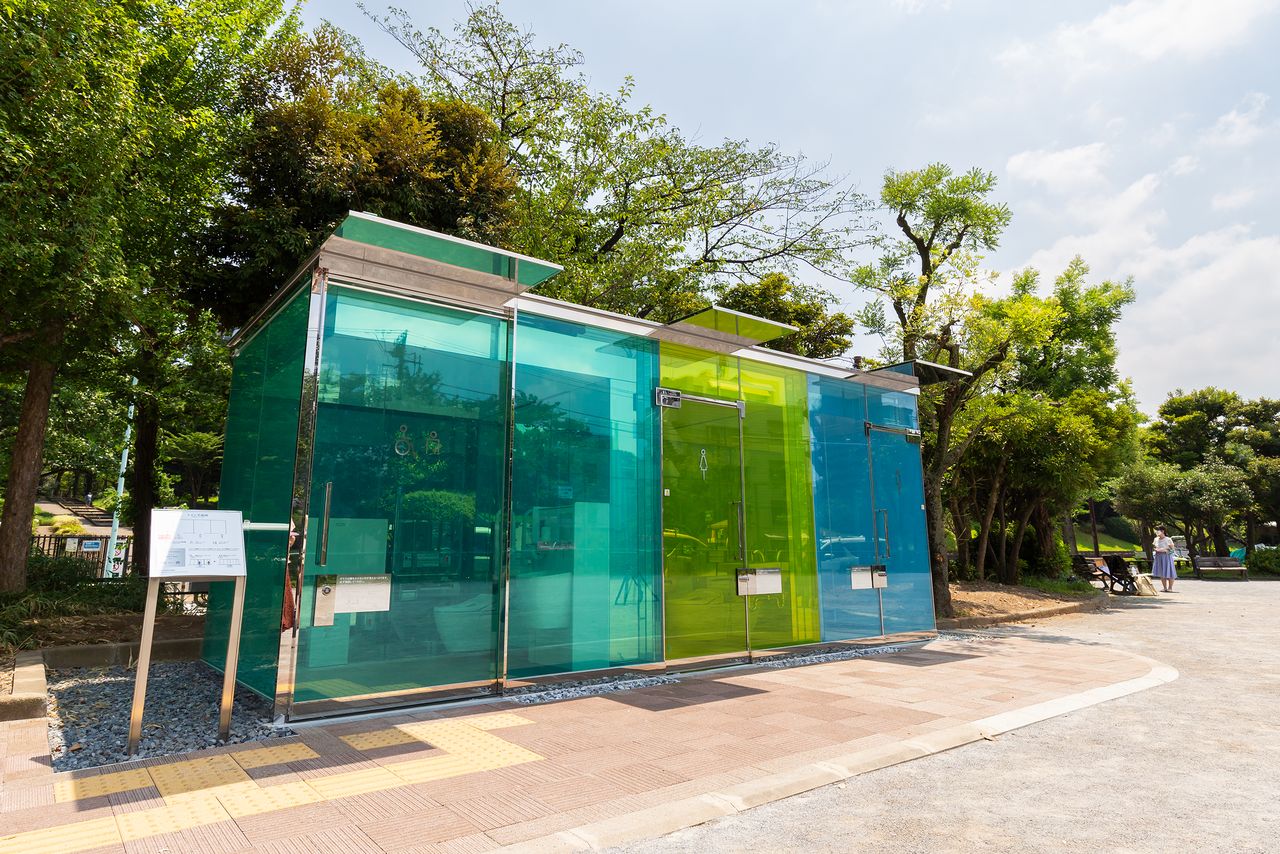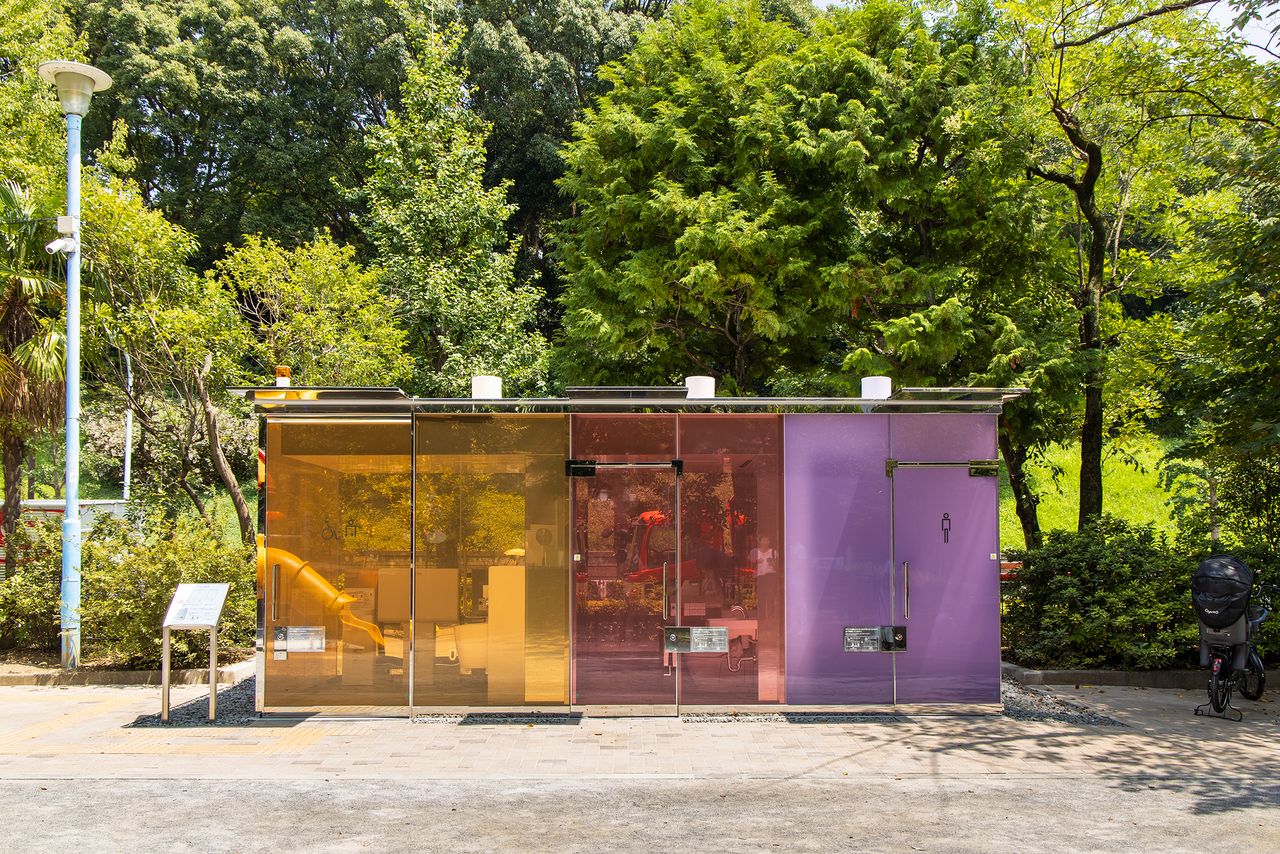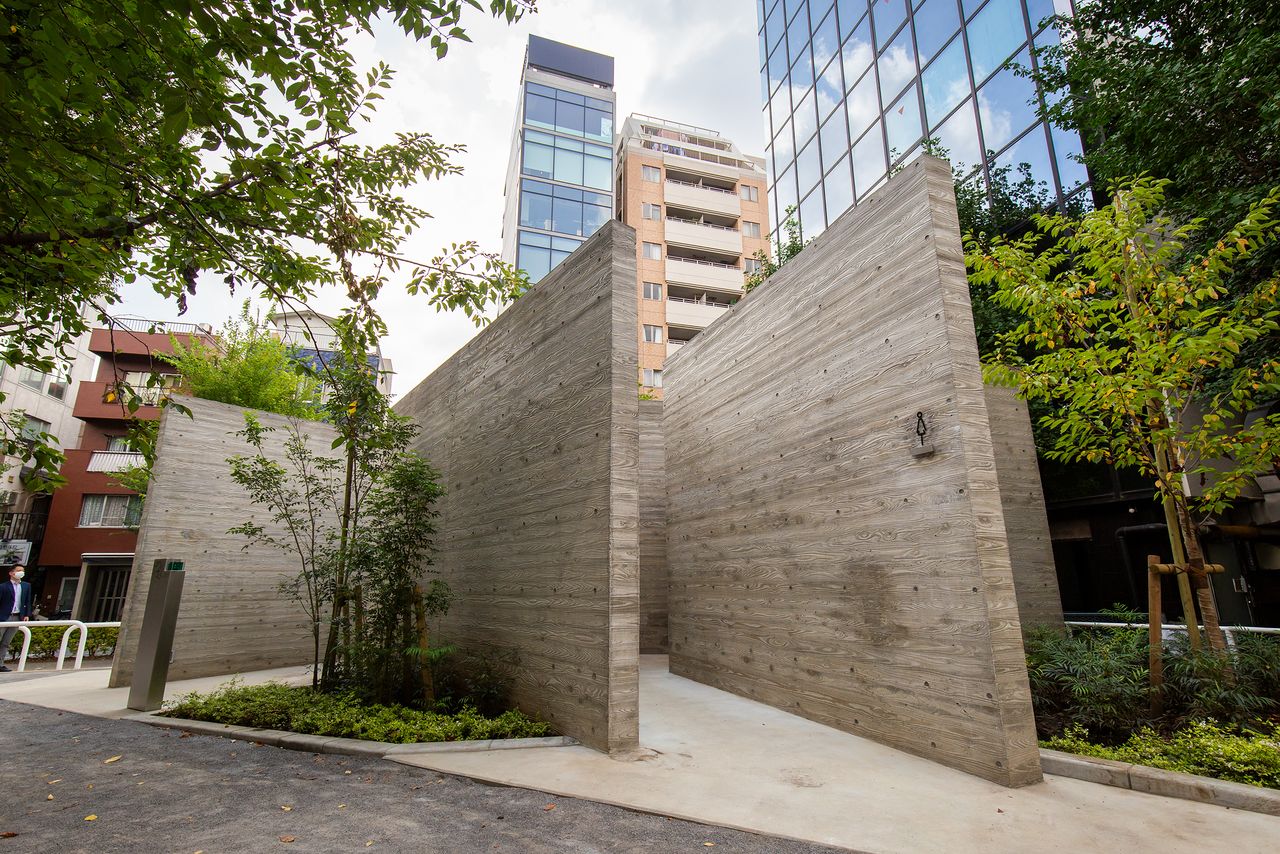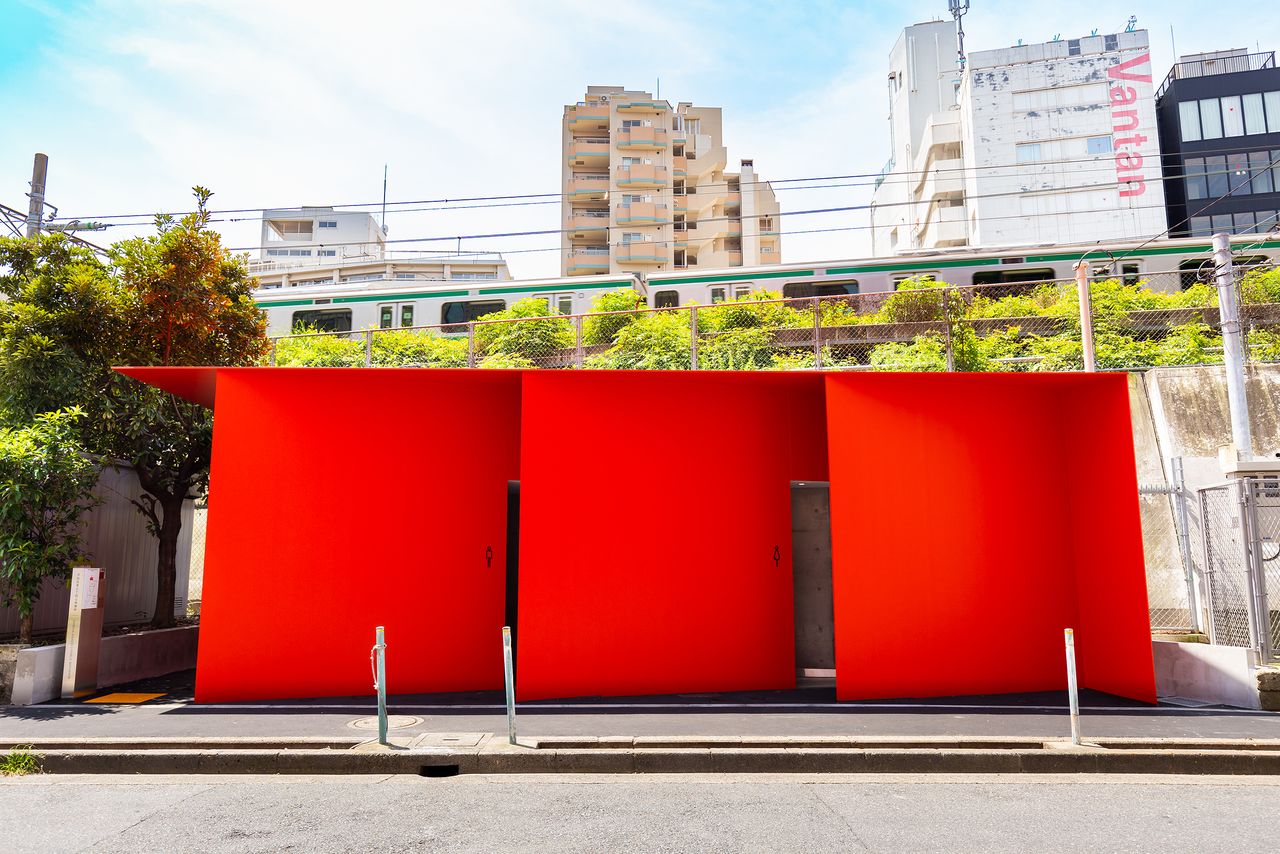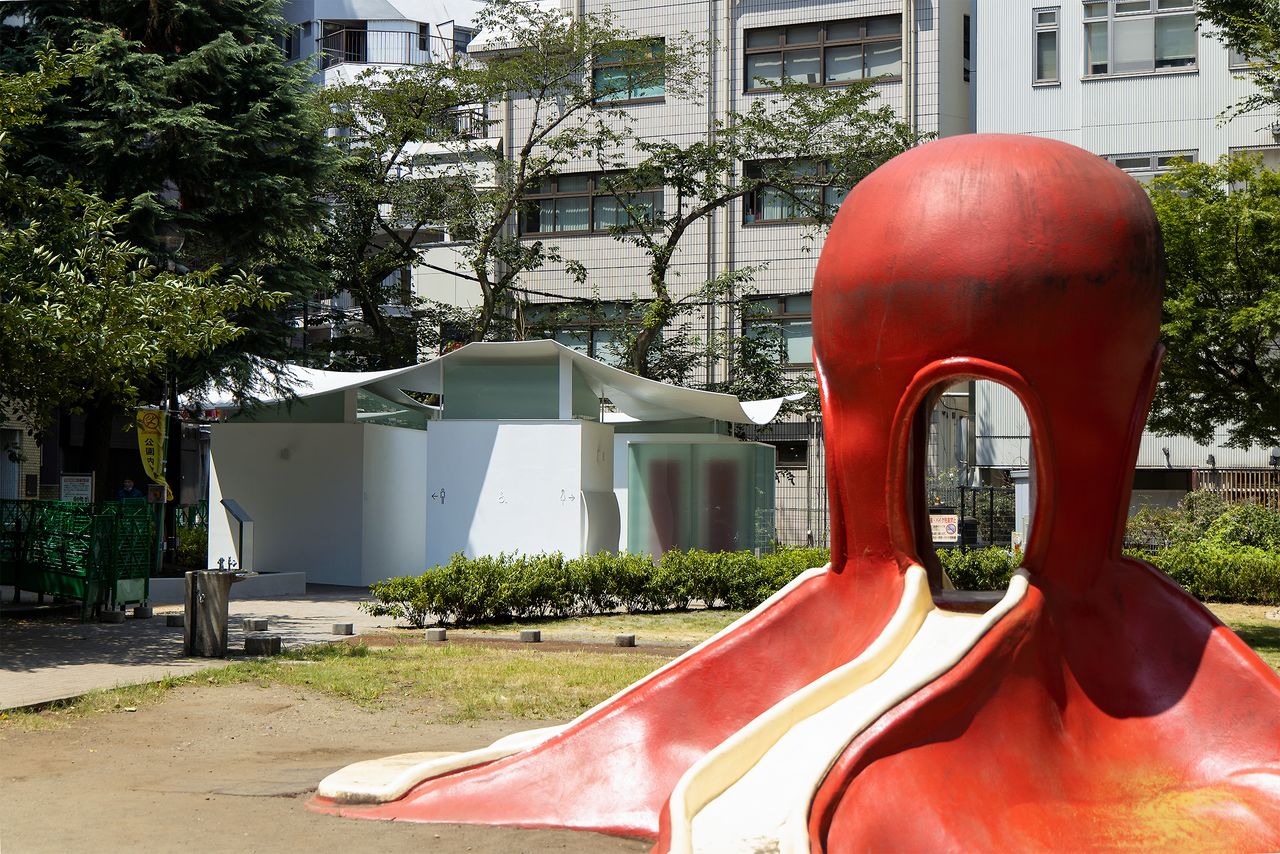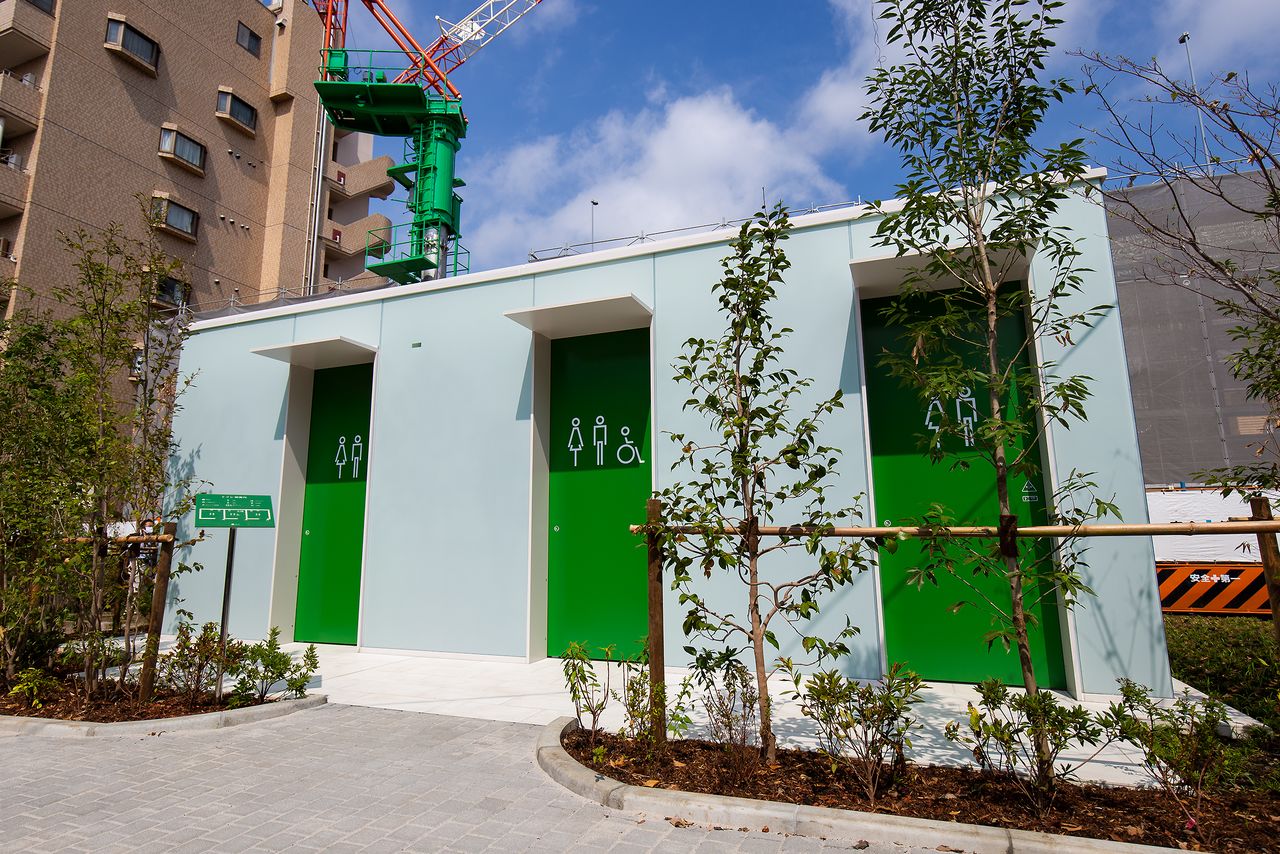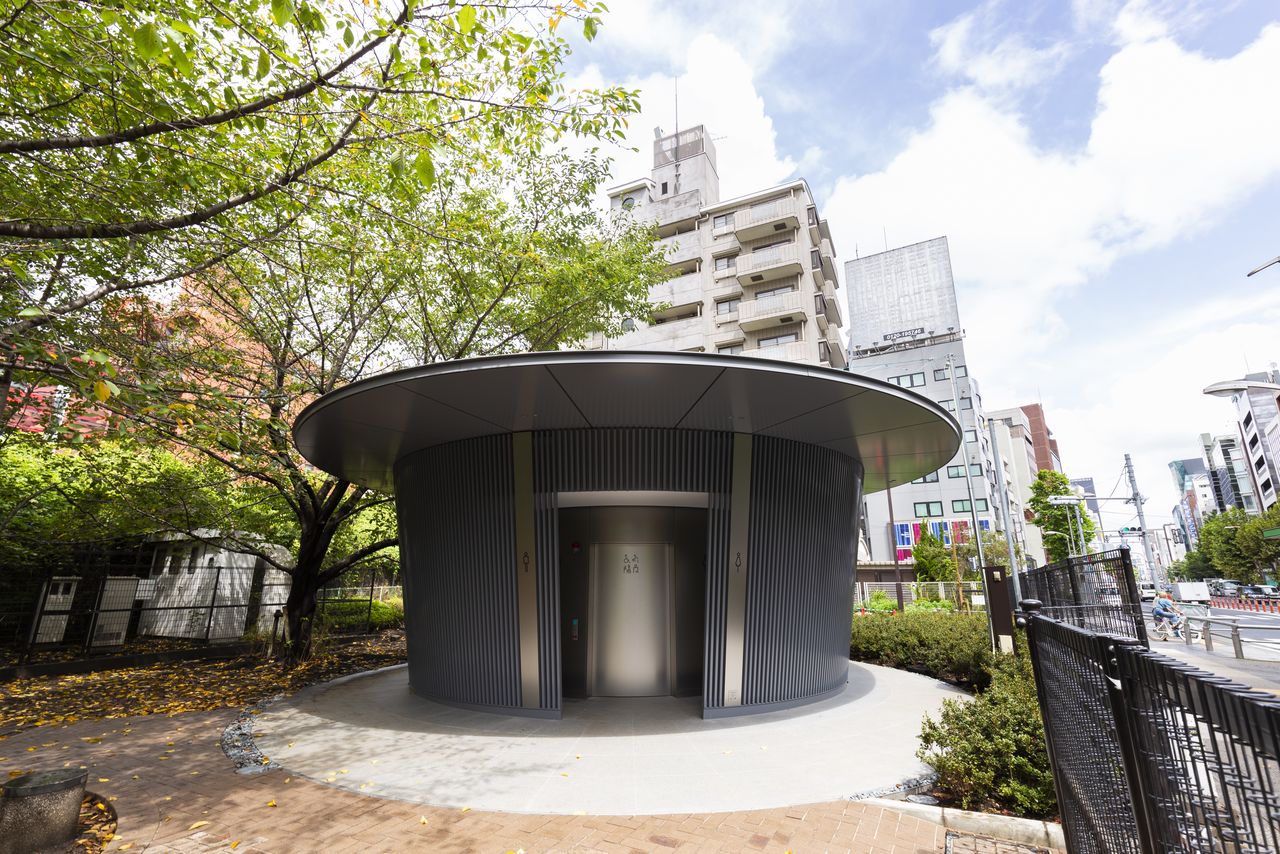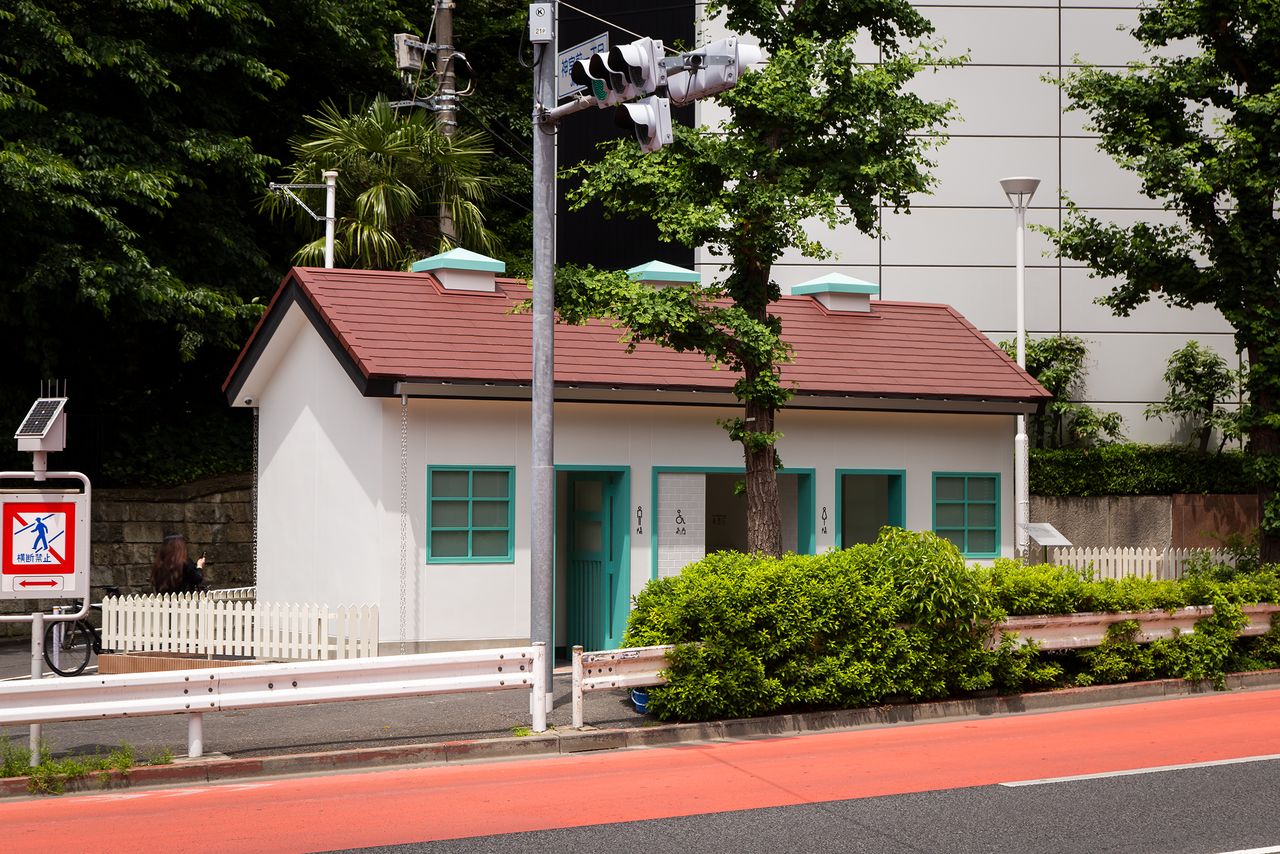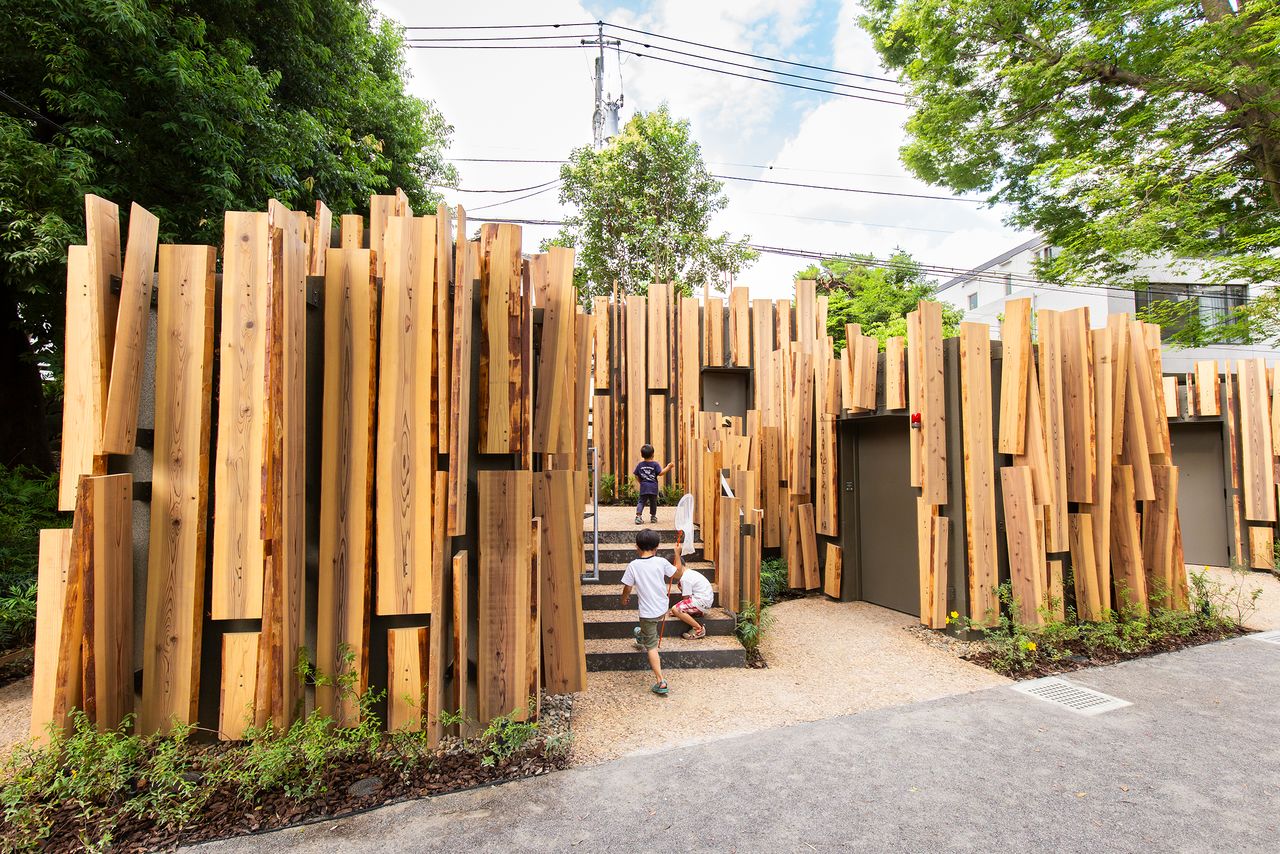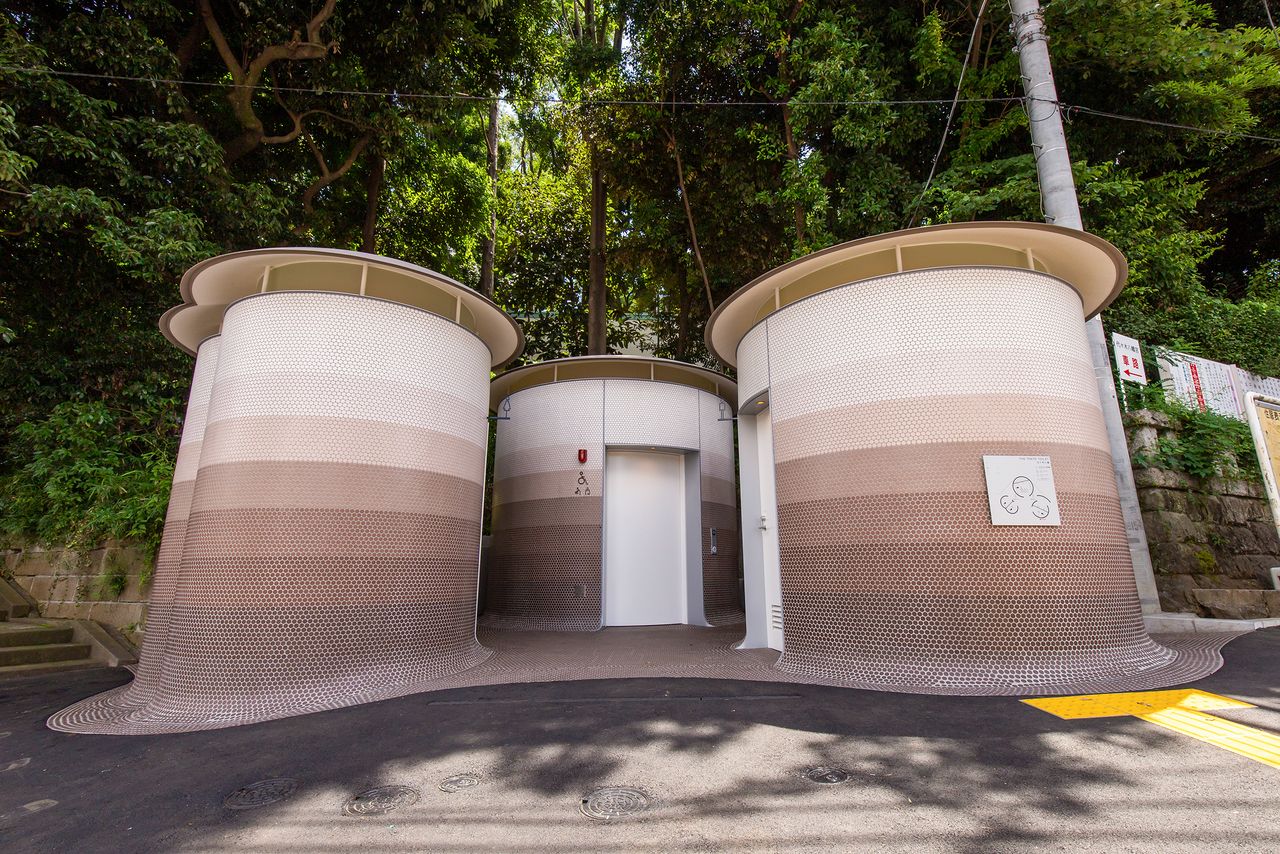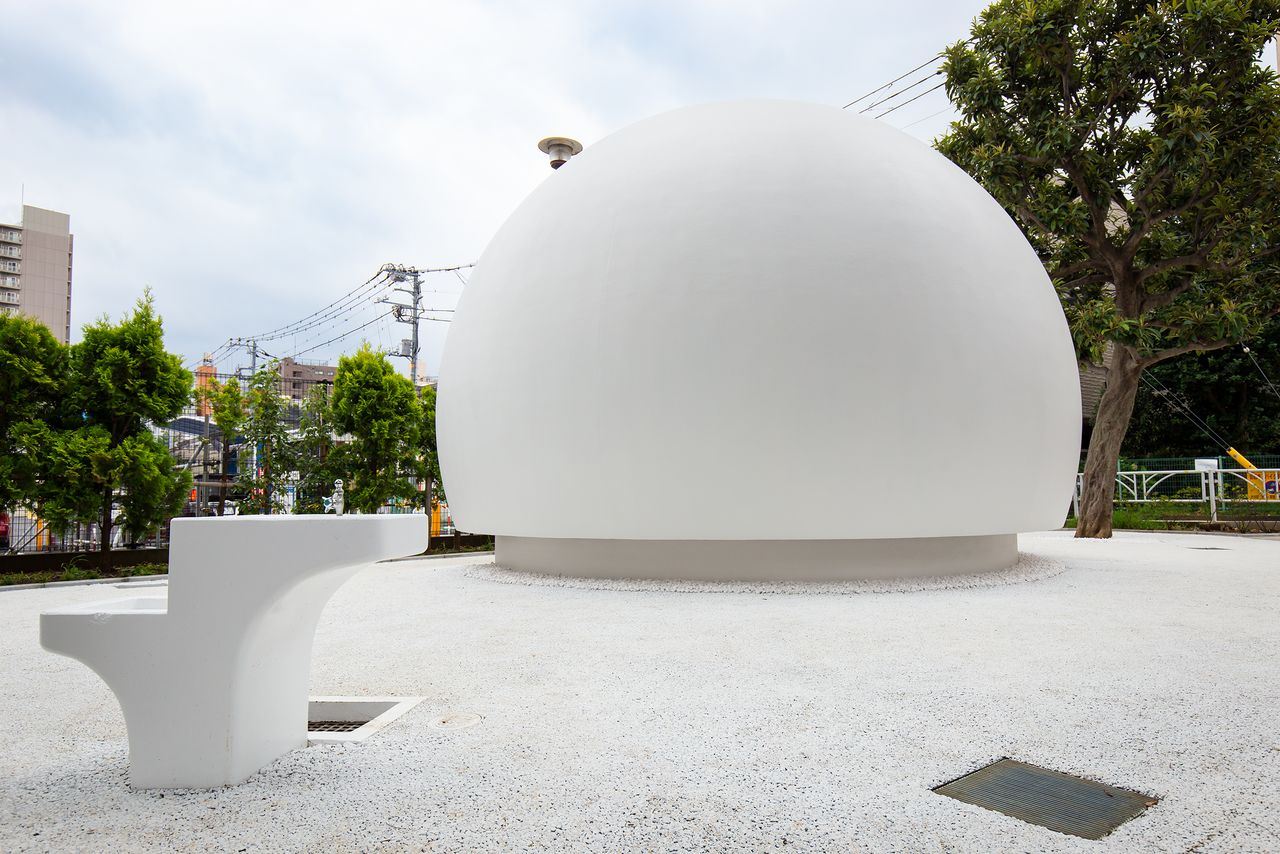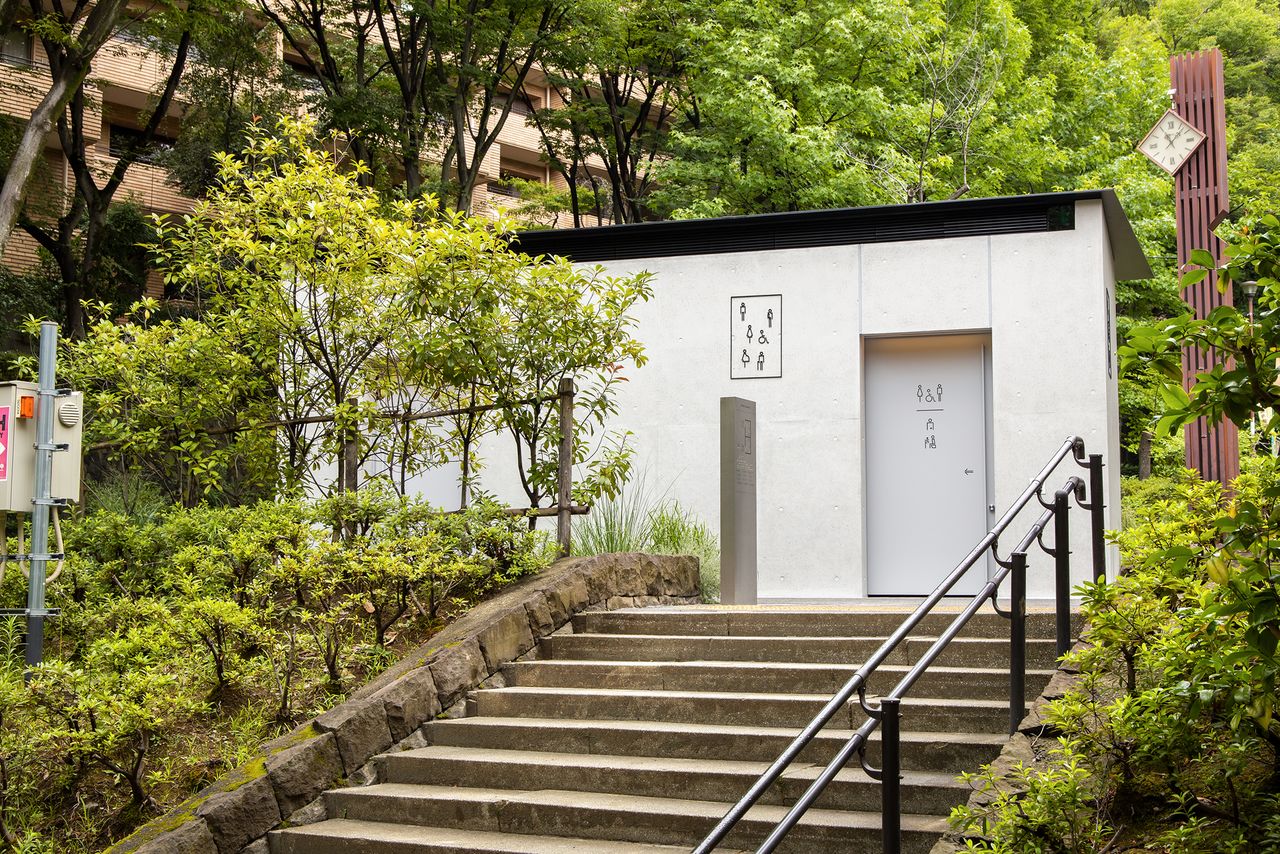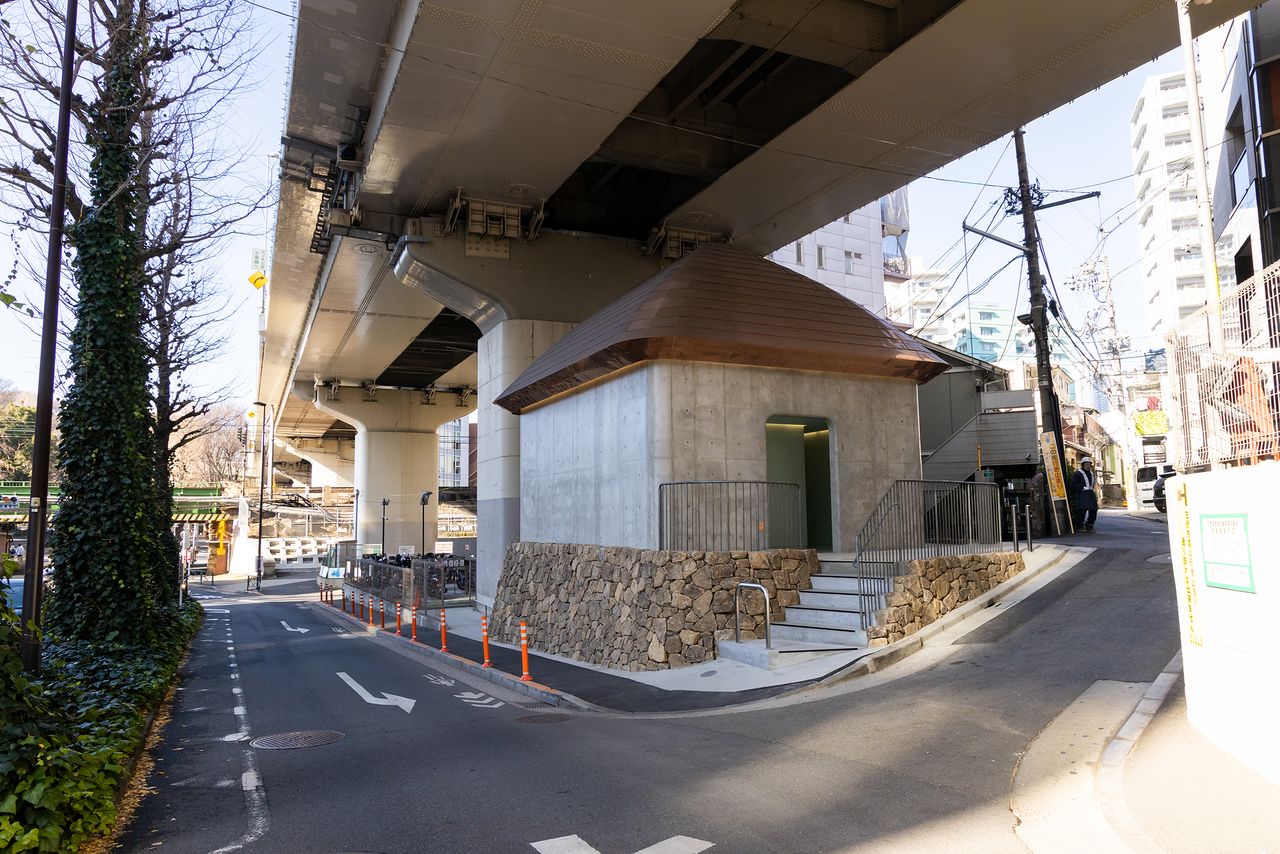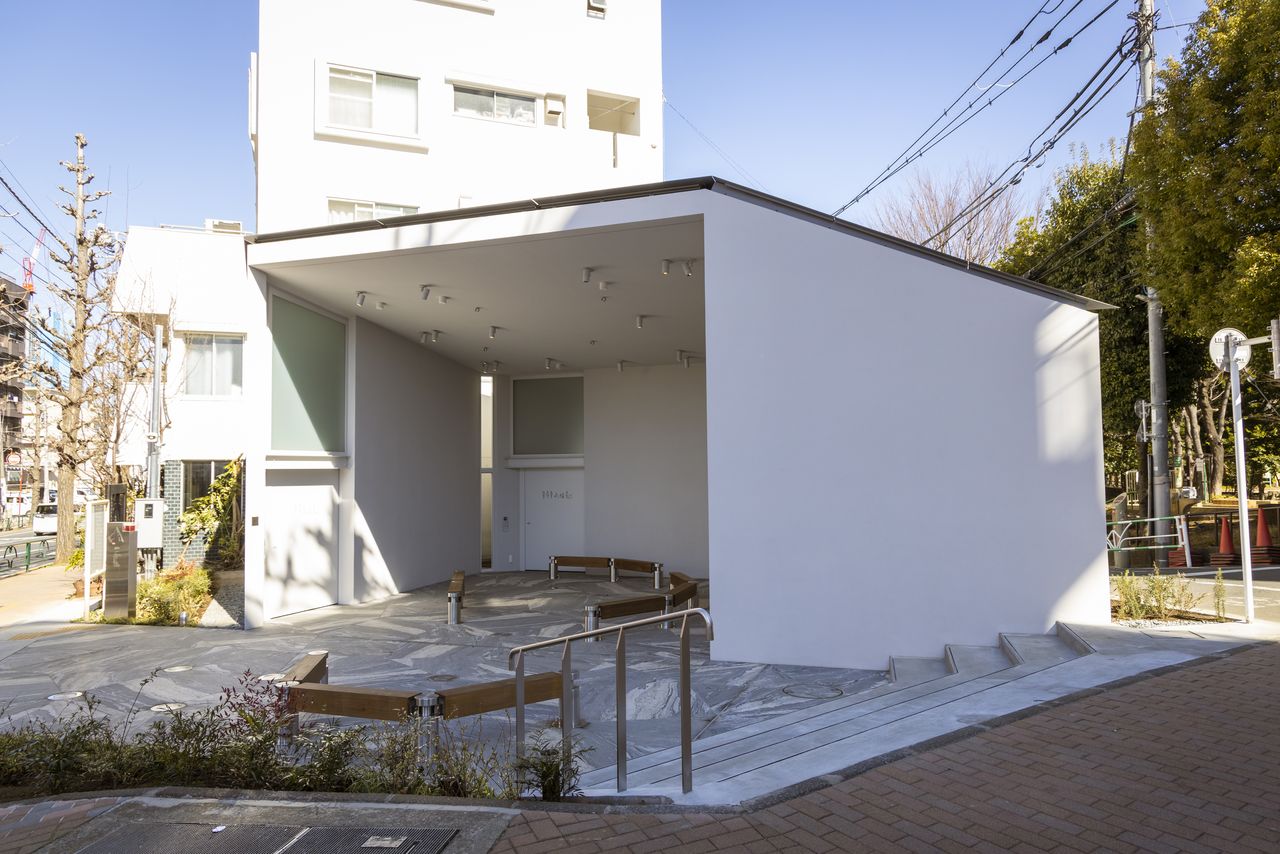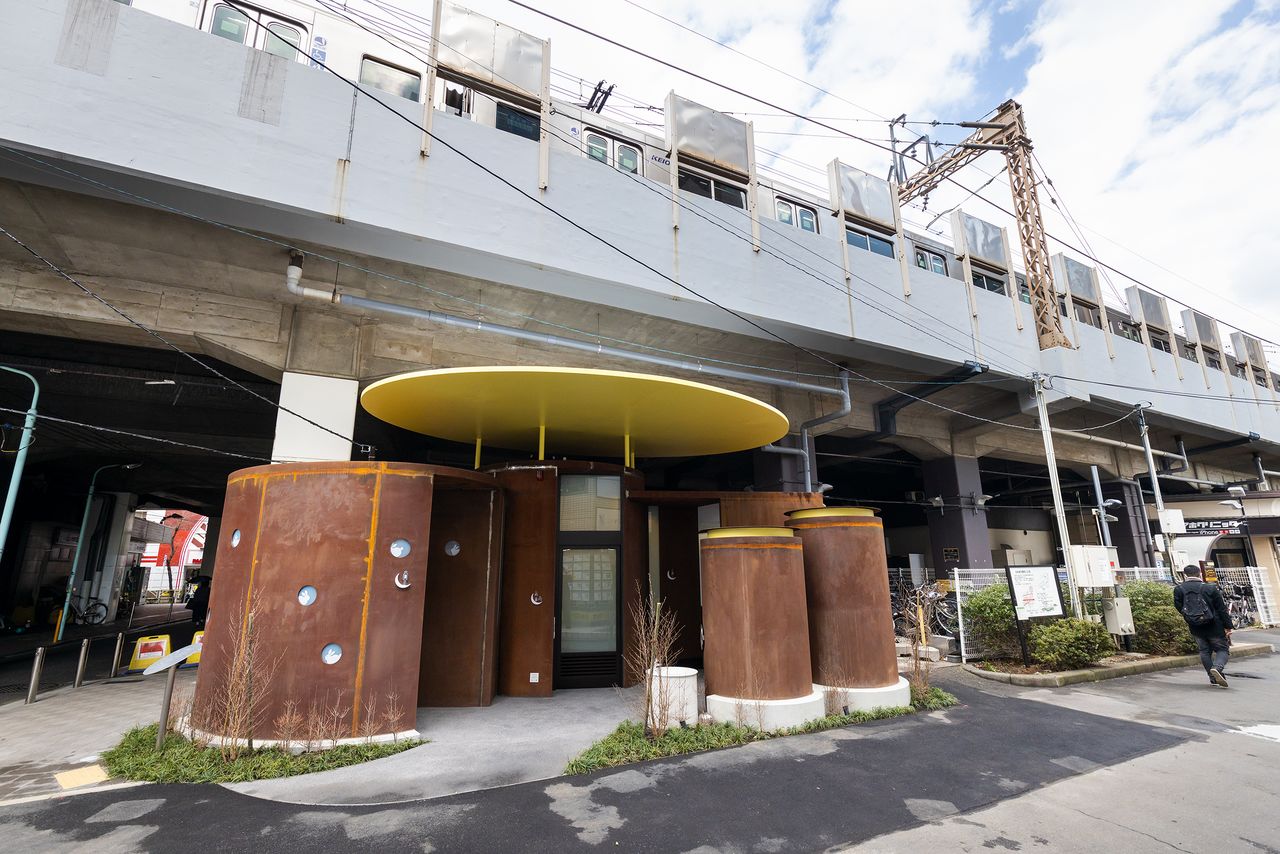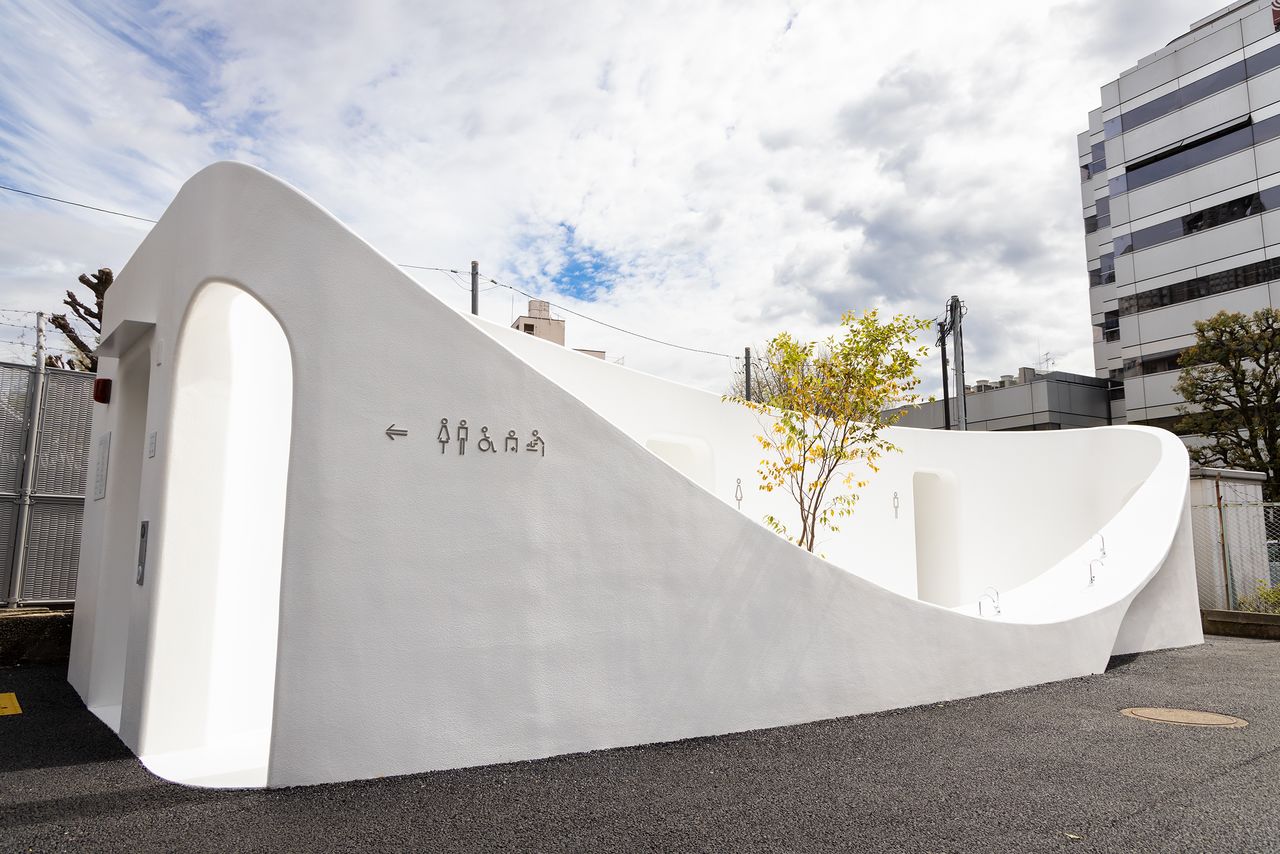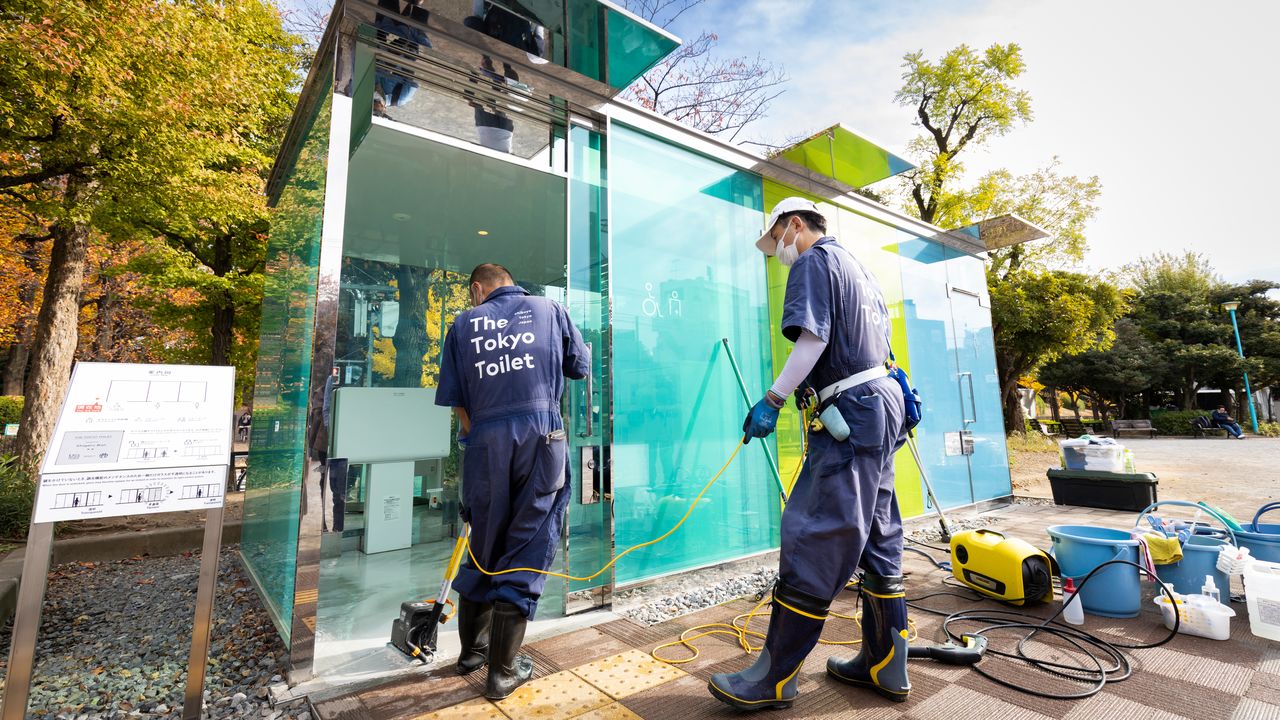
The Tokyo Toilet Project Makes a Splash in Shibuya and Cannes
Guide to Japan Architecture- English
- 日本語
- 简体字
- 繁體字
- Français
- Español
- العربية
- Русский
Spick and Span Image
Since 2020, the Tokyo Toilet Project has drawn attention with its designer restrooms in Shibuya created by such world-renowned figures as Ban Shigeru, Kuma Kengo, and Andō Tadao. In May, the buzz spread abroad with acclaimed German director Wim Wenders bringing Perfect Days, a movie featuring the initiative, to the Cannes Film Festival. Starring Yakusho Kōji, the film tells the story of a simple man of few words who earns a living scrubbing public lavatories. Yakusho won best actor for his performance, becoming the second Japanese actor to do so after Yagira Yūya, who took the prize in 2004 for his role in Koreeda Hirokazu’s Nobody Knows.
In mid-June, Yakusho spoke at the Japan National Press Club in Tokyo about his involvement in the movie. Looking back, he described being taken with the character when Wenders offered him the leading part, declaring that “the role called to me.” Sweetening the offer was the chance to work with the legendary German director, an opportunity Yakusho characterized as “an incredible honor.”
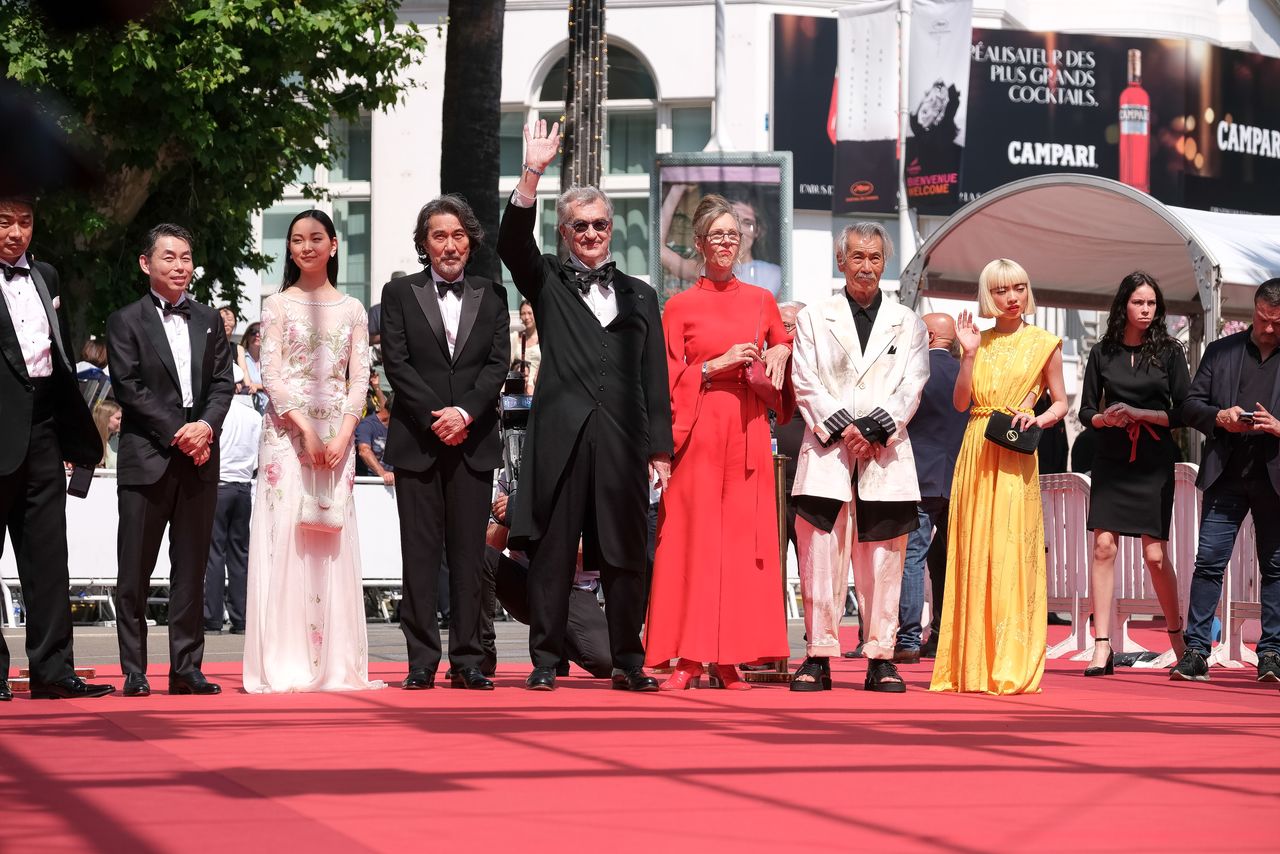
Yakusho Kōji (fourth from left), Wim Wenders (center), and other members of the cast and crew of Perfect Days on the red carpet at the Cannes Film Festival. (© Wakayama Kazuko)
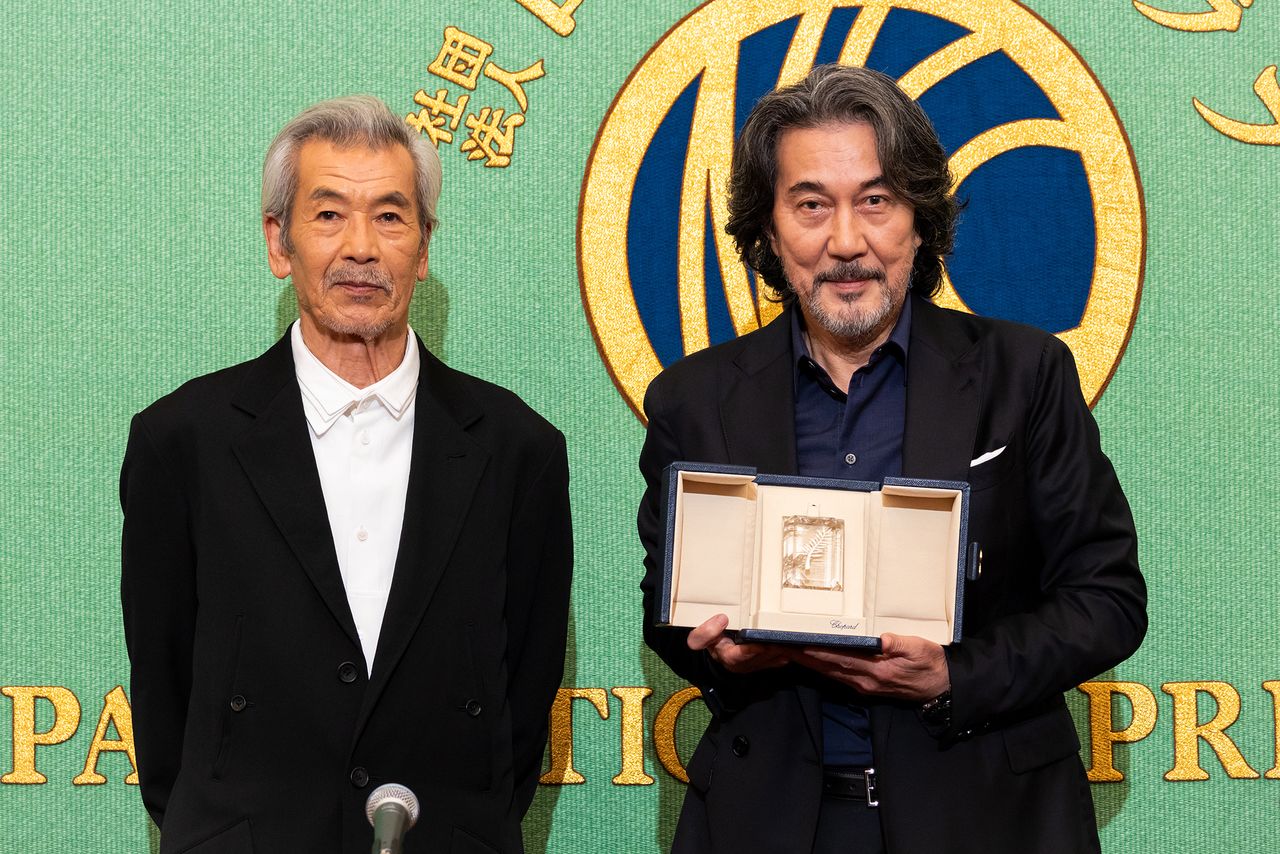
Yakusho (right) shows off his award for best actor at the Japan National Press Club. He was joined at the event by Japanese costar Tanaka Min.
The Tokyo Toilet Project serves as a backdrop for Better Days. Conceived by Yanai Kōji, president of Uniqlo clothing chain operator Fast Retailing, the initiative aims to change the popular perceptions that public toilets are smelly, dark, dirty, and dangerous with eye-catching facilities that are accessible to all members of society. Spearheaded by the Nippon Foundation, it enlisted 16 creators to design innovative, imaginative facilities around Shibuya. Yanai also had a hand in the production of Perfect Days.
Yakusho said that he worked closely with maintenance staff of the public restrooms to prepare for his part, including undergoing two days of training on cleaning procedures and consulting with the workers during filming. The actor says that he came away from the experience with a different view of public restrooms, noting that “the facilities help project a positive image of Japan.”
Yakusho admits that he was moved by the joyous reaction of his coworkers on Perfect Days to his winning the best actor award. Looking ahead, he hopes to serve as a guide in bringing up a new generation of actors, saying that “the industry boasts a long history of exceptional talent, and building on this, I want to help create something on par with the golden age of Japanese cinema.”
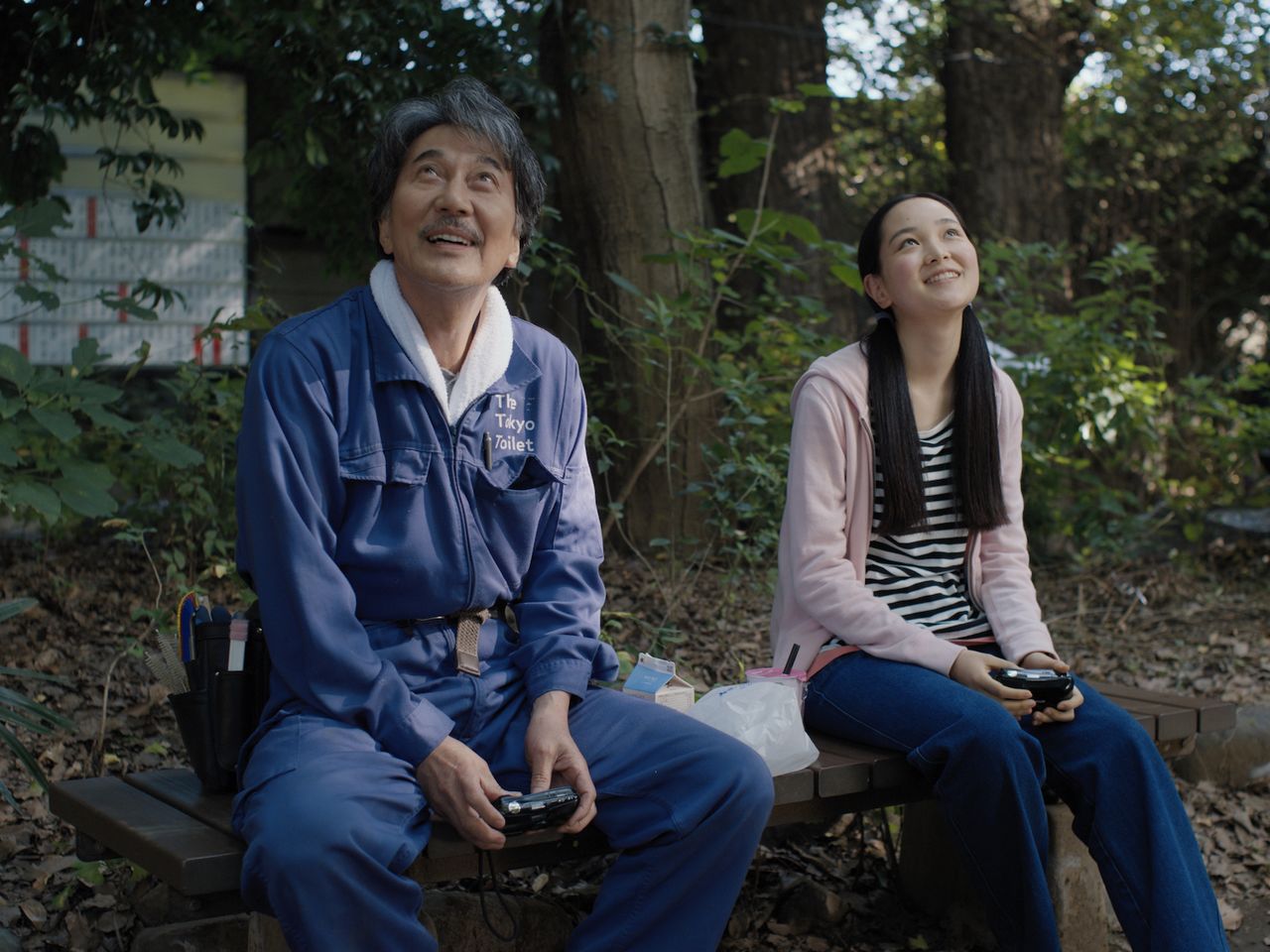
Yakusho (left) as Hirayama, a cleaner of public restrooms who has learned to appreciate life’s small joys. The movie used the same uniforms used by actual cleaning staff, which were created by Japanese designer Nigo specifically for the Tokyo Toilet Project. (© 2023 Master Mind Ltd.)
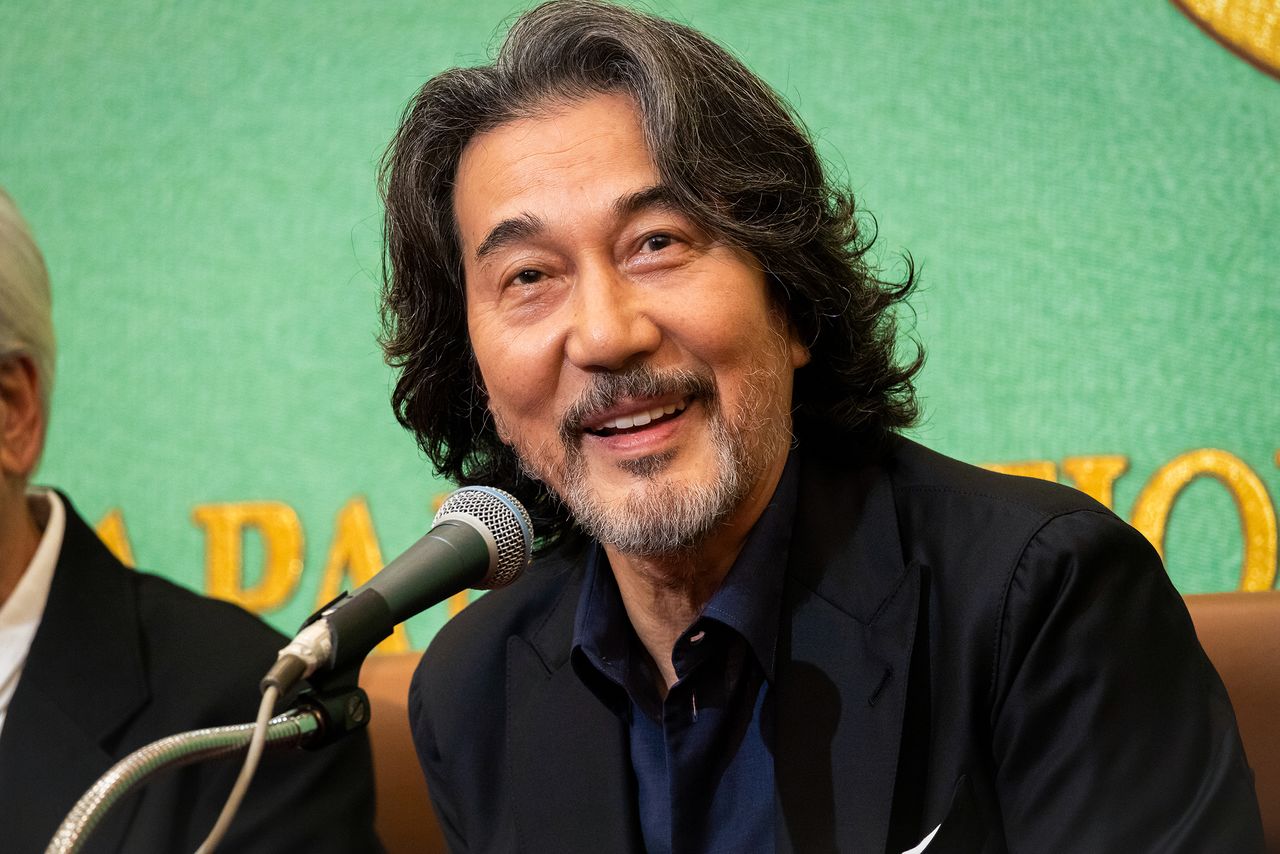
Yakusho speaks at the Japan National Press Club.
The Next Phase
The Tokyo Toilet Project’s seventeenth and final restroom was finished in March of this year, with the Nippon Foundation officially passing it to Shibuya at a ceremony on June 23. The project is already having an impact by improving the image of public toilets. According to a survey conducted by the foundation, usage of the 17 facilities by women are on the rise. Compared to before the restrooms were renovated, use of the Hatagaya and Nishisandō Public Toilets have increased sevenfold and fivefold, respectively. Satisfaction with the facilities among users has also swelled from 44% to nearly 90%, while the number of people voicing aversion to public toilets shrank from some 30% to a mere 3%.
The survey also saw a significant drop in respondents indifferent to public toilets, which went from around 30% to 8%, an outcome that Nippon Foundation Executive Director Sasakawa Junpei touts as proof that the project is having an effect. “People who previously didn’t give much thought to public toilets have started to take an interest in the facilities.” The hope is that access to attractive and clean public toilets will boost the image of surrounding areas, with the facilities becoming tourist attractions in their own right.
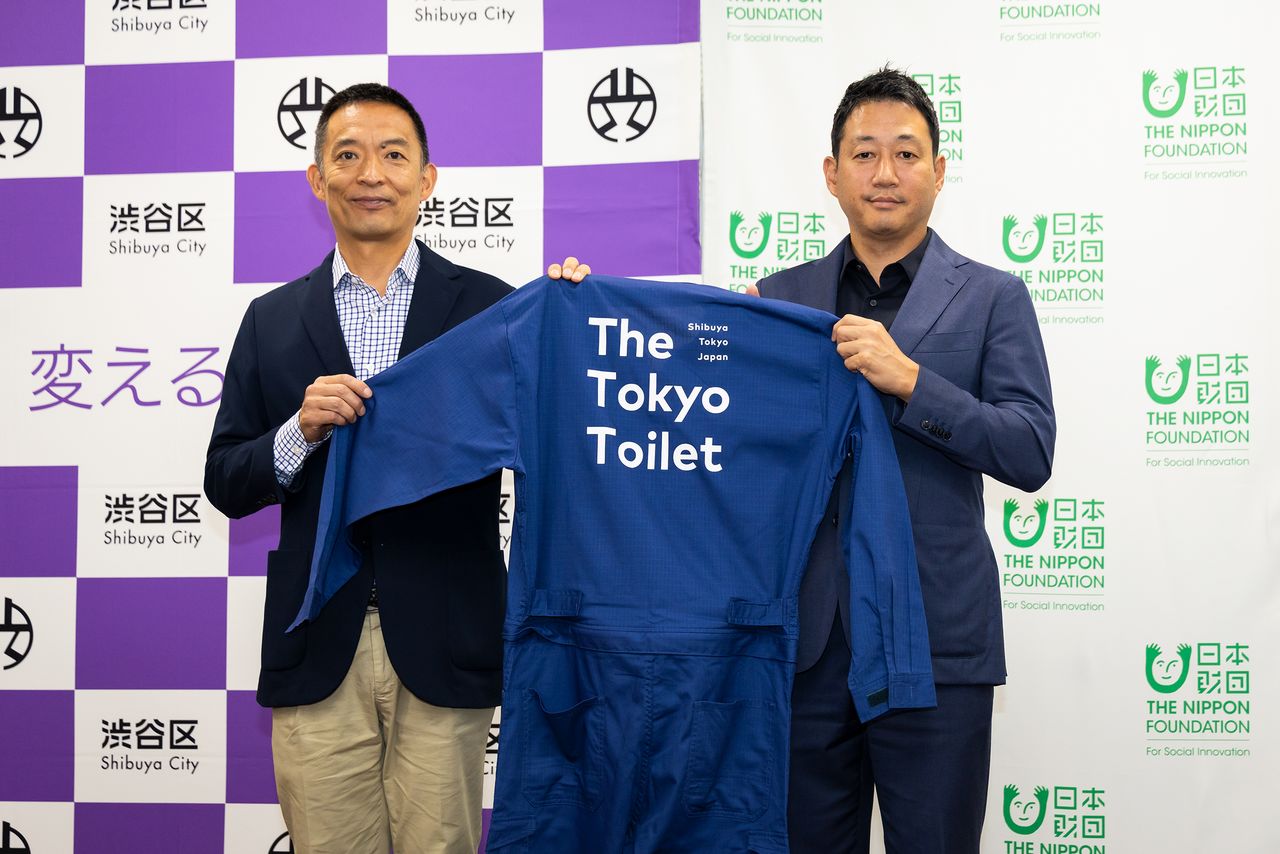
Shibuya Mayor Hasebe Ken, left, and Nippon Foundation Executive Director Sasakawa Junpei.
Recognizing that maintaining the public toilets is key to sustaining their appeal, Yanai looked to the Silver Screen to get the word out about the importance the project places on keeping the facilities in working and pristine condition. “I wanted to portray this concept clearly and realistically,” he says, adding that he was “overjoyed” that the film wound up winning an award.
The Nippon Foundation will be involved in the upkeep of facilities through the current fiscal year ending in March 2024, when Shibuya will fully take over their care. But Yanai says that for his part, he intends to continue supporting the endeavor. “If people use the facilities every day,” he insists, “they’ll need to be cleaned, kept free of graffiti and the like, and have well-maintained equipment. The project keeps chugging along.”
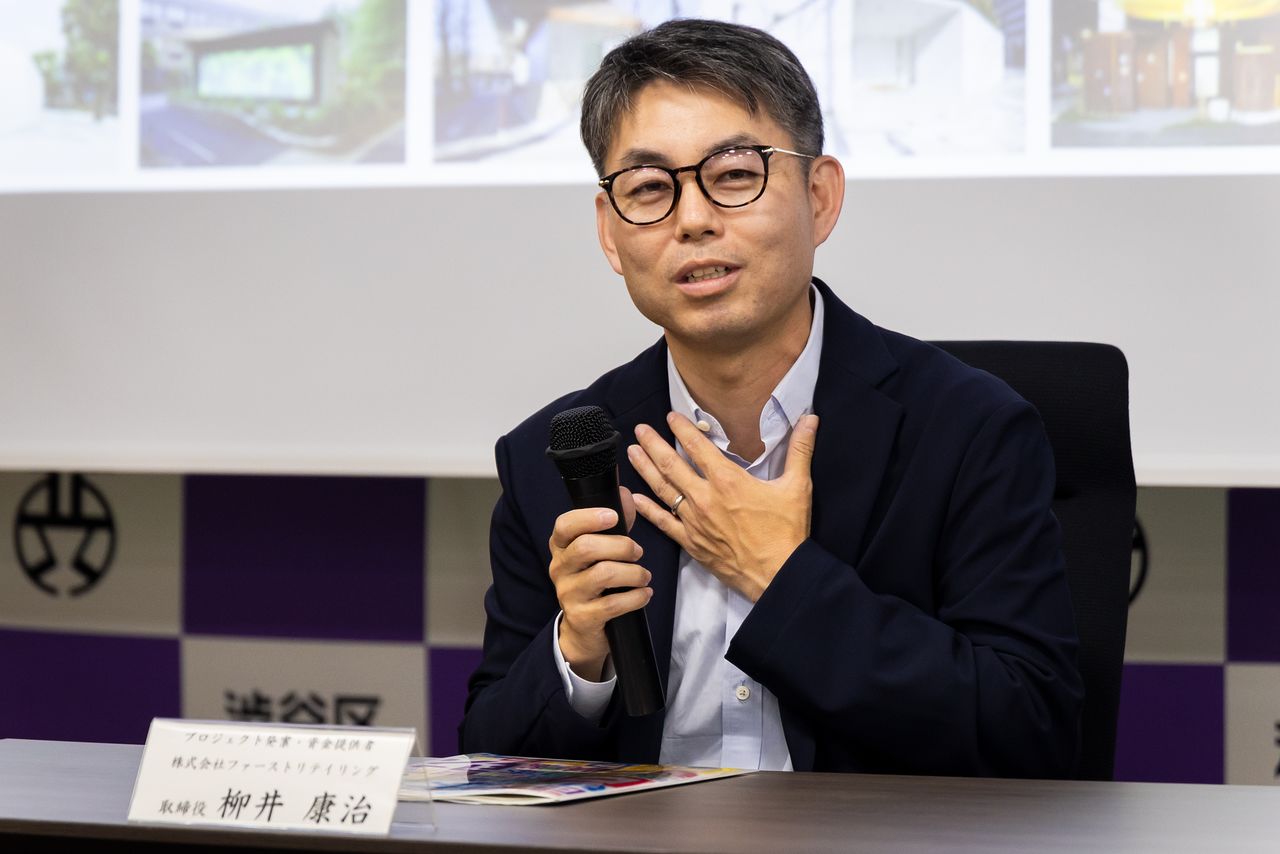
Yanai Kōji, president of Fast Retailing, maker of the Uniqlo brand.
The Tokyo Toilet Gallery
■Ban Shigeru
Haru no Ogawa Community Park (5-68-1 Yoyogi)
Yoyogi Fukamachi Minipark (1-54-1 Tomigaya)
Award-winning architect Ban Shigeru chose a startling, see-through design for his public toilets. Pictured here is the Haru no Ogawa Community Park facility.
Ban’s Yoyogi Fukamachi Minipark facility provides a colorful touch. The clear walls turn opaque when the doors are locked.
■Katayama Masamichi/Wonderwall
Ebisu Park (1-19-1 Ebisu-nishi)
Interior designer Katayama Masamichi used 15 carefully arranged walls to give the toilet a playful, labyrinth-like feel.
■Tamura Nao
Higashi Sanchōme Public Toilet (3-27-1 Higashi)
New York-based product designer Tamura Nao’s toilet is sandwiched between a road and a concrete railway embankment. The building’s red walls are like sheets of origami paper, carefully arranged to give users a sense of privacy and safety.
■Maki Fumihiko
Ebisu East Park (1-2-16 Ebisu)
The elegantly curved roof of architect Maki Fumihiko’s creation adds a squid-like presence to the undersea feel at what is known locally as “octopus park.”
■Sakakura Takenosuke
Nishihara Itchōme Park (1-29-1 Nishihara)
Architect Sakakura Takenosuke turned what was a dilapidated, seldom-used public restroom into an inviting space, with the facility’s illuminated exterior also brightening the park at night.
■Andō Tadao
Jingū-dōri Park (6-22-8 Jingūmae)
Named Amayadori, meaning “rain shelter” in Japanese, architect Andō Tadao’s creation features a broad roof that offers pedestrians refuge from sudden, inclement weather, and a circular outer wall that lets in natural light while providing privacy.
■Nigo
Jingūmae Public Toilet (Jingūmae 1-3)
This public toilet by locally based fashion designer Nigo blends newness with the retro feel of US military housing in one of the first neighborhoods in Tokyo where American culture established a foothold.
■Kuma Kengo
Nabeshima Shōtō Park Toilet (Shōtō 2-10-7)
Kuma Kengo, an architect known for his abundant use of wood, clad the public toilet in cedar planks to create a forest-like feel that harmonizes with the greenery of the surrounding park.
■Itō Toyō
Yoyogi Hachiman Public Toilet (Yoyogi 5-1-2)
Architect Itō Toyō created three toilets resembling mushrooms sprouting from the forest of neighboring Yoyogi Hachiman Shrine that blend seamlessly with the surrounding greenery.
■Satō Kashiwa
Ebisu Station West Exit Public Toilet (Ebisu Minami 1-5-8)
The pure-white cube by Satō Kashiwa, one of Japan’s best-known art directors, has a simple design that projects cleanliness. The entrance at the back gives a degree of privacy in the busy station-front location.
■Satō Kazoo/Disruption Lab Team
Nanagō Dōri Park Toilet (Hatagaya 2-53-5)
Satō Kazoo, designer and chief creative officer at TBWA Hakuhōdō, created a white, dome-like toilet that features contactless controls like voice commands to open doors and foot levers for flushing.
■Ushiro Tomohito
Hiroo Higashi Park Toilet (Hiroo 4-2-27)
Ushiro Tomohito, creative director in charge of Uniqlo’s sustainability division, designed the public toilet to suggest a stone monument while also projecting simplicity and ease of use. The rear of the structure has a panel that lights up in 7.9 billion ways.
■Mark Newson
Urasandō Public Toilet (Sendagaya 4-28-1)
The public toilet by Australian Mark Newson, a contemporary product designer, contains traditional elements like a copper roof similar to those used for shrines and temples and stacked stone walls that project an air of traditional Japanese architecture.
■Miles Pennington and UTokyo DLX Design Lab
Hatagaya Public Toilet (Hatagaya 3-37-8)
Professor Miles Pennington and the UTokyo DLX Design Lab created this facility on the concept of “With Toilet.” The structure has white walls that are ideal for displaying art or for projecting images and a multi-purpose space that can be arranged into different layouts. Since renovation, use of the public toilet by women has increased significantly.
■Kobayashi Junko
Sasazuka Greenway Public Toilet (Sasazuka 1-29)
The numerous apertures of this toilet by Kobayashi Junko, head of the Japan Toilet Association, make the light-filled interior feel warm and safe. It features a wide opening that is easily accessible to wheelchairs and children’s toilets near the entrance that make it easy for parents to easily keep an eye on their charges.
■Fujimoto Sou
Nishisandō Public Toilet (Yoyogi 3-27-1)
Architect Fujimoto Sou pictured this public toilet as a shared urban oasis for freshening up. Modeled on the concepts of “container” and “water source,” it has multipurpose facilities and six faucets installed at differing heights to serve the needs of any passerby.
(Originally published in Japanese. Banner photo: Workers clean the see-through toilet at Haru no Ogawa Community Park. All photos © Hashino Yukinori of Nippon.com.)
